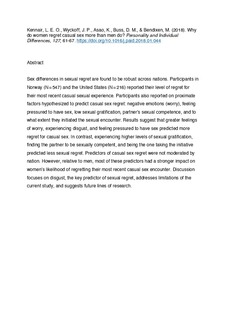| dc.contributor.author | Kennair, Leif Edward Ottesen | |
| dc.contributor.author | Wyckoff, Joy P. | |
| dc.contributor.author | Asao, Kelly | |
| dc.contributor.author | Buss, David M. | |
| dc.contributor.author | Bendixen, Mons | |
| dc.date.accessioned | 2019-04-11T13:19:25Z | |
| dc.date.available | 2019-04-11T13:19:25Z | |
| dc.date.created | 2018-05-09T12:23:46Z | |
| dc.date.issued | 2018 | |
| dc.identifier.citation | Personality and Individual Differences. 2018, 127 61-67. | nb_NO |
| dc.identifier.issn | 0191-8869 | |
| dc.identifier.uri | http://hdl.handle.net/11250/2594304 | |
| dc.description.abstract | Sex differences in sexual regret are found to be robust across nations. Participants in Norway (N = 547) and the United States (N = 216) reported their level of regret for their most recent casual sexual experience. Participants also reported on proximate factors hypothesized to predict casual sex regret: negative emotions (worry), feeling pressured to have sex, low sexual gratification, partner's sexual competence, and to what extent they initiated the sexual encounter.
Results suggest that greater feelings of worry, experiencing disgust, and feeling pressured to have sex predicted more regret for casual sex. In contrast, experiencing higher levels of sexual gratification, finding the partner to be sexually competent, and being the one taking the initiative predicted less sexual regret. Predictors of casual sex regret were not moderated by nation. However, relative to men, most of these predictors had a stronger impact on women's likelihood of regretting their most recent casual sex encounter. Discussion focuses on disgust, the key predictor of sexual regret, addresses limitations of the current study, and suggests future lines of research. | nb_NO |
| dc.language.iso | eng | nb_NO |
| dc.publisher | Elsevier | nb_NO |
| dc.rights | Attribution-NonCommercial-NoDerivatives 4.0 Internasjonal | * |
| dc.rights.uri | http://creativecommons.org/licenses/by-nc-nd/4.0/deed.no | * |
| dc.title | Why do women regret casual sex more than men do? | nb_NO |
| dc.type | Journal article | nb_NO |
| dc.type | Peer reviewed | nb_NO |
| dc.description.version | acceptedVersion | nb_NO |
| dc.source.pagenumber | 61-67 | nb_NO |
| dc.source.volume | 127 | nb_NO |
| dc.source.journal | Personality and Individual Differences | nb_NO |
| dc.identifier.doi | 10.1016/j.paid.2018.01.044 | |
| dc.identifier.cristin | 1584322 | |
| dc.description.localcode | © 2018. This is the authors’ accepted and refereed manuscript to the article. Locked until 9.2.2020 due to copyright restrictions. This manuscript version is made available under the CC-BY-NC-ND 4.0 license http://creativecommons.org/licenses/by-nc-nd/4.0/ | nb_NO |
| cristin.unitcode | 194,67,40,0 | |
| cristin.unitname | Institutt for psykologi | |
| cristin.ispublished | true | |
| cristin.fulltext | original | |
| cristin.qualitycode | 1 | |

